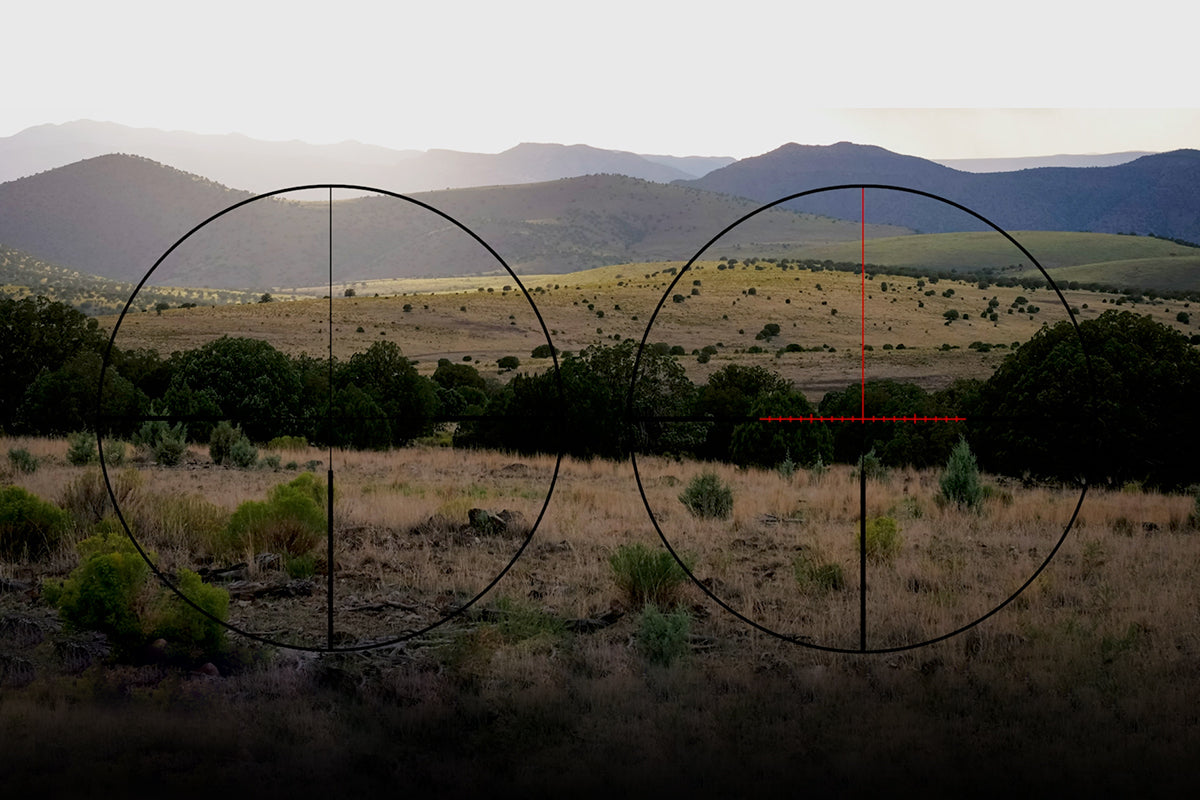on all orders over $1000

How to Choose a Rifle Scope Reticle
The world of precision rifles continues to grow as more people compete in matches and learn to hunt. In response to this explosion of interest, rifle scope manufacturers are constantly developing new ways to meet the demands of their customer base. One way they accomplish this is through the development of reticles.
Somehow, reticles have become a topic of controversy as precision enthusiasts and hunters alike flock to their camps and echo chambers to argue their points, each idea better than the other. If learning more about rifle scope reticles sounds more appealing than falling over your spear to stab someone, this article is for you.
Truthfully, the greatest contributor to the growing number of reticle choices is the prospect of creating a cash cow from a licensed reticle design. Reticles that become popular are often adopted by other rifle scope manufacturers who pay licensing fees to use them in their rifle scopes.
The other major factor stems from the growing number of notable shooting schools and instructors. Most shooters have no formal training with optics and find their first experience learning about reticles with an instructor they look up to explaining how to use it. This is powerful messaging and probably contributes to the cult-like mentality some have when it comes to reticles.
Christmas Tree Reticles
Nearly all of the emphatic opinions surrounding reticles correspond to some style of bullet drop compensating (or BDC) reticle, some of which are referred to as “Christmas tree reticles.” Popularized largely by Horus Vision, there are now dozens of these reticles in use across a variety of different manufacturers.
To the dismay of some and the relief of others, this article will not even begin to delve into the efficacy of the endless BDC reticle options on the market, as it is not the purpose of this article. Rather, we’ll explain more broadly what they were all designed to accomplish and how they may or may not fit your needs.
As the term implies, bullet drop compensating reticles are designed to allow shooters to adjust for bullet drop using the reticle as opposed to the elevation turret. The term “Christmas tree reticle” comes from BDC reticles which feature increasing numbers of windage hash marks toward the bottom of the reticle resulting in a tree-like appearance.

Now that we’ve established the purpose of BDC reticles, we’ll explore where they tend to see more use. For most competitive shooters in the Precision Rifle Series and National Rifle League matches, BDC reticles are extremely popular. The reason for this is that BDC reticles allow shooters to quickly adapt to environmental changes like wind velocity at any magnification, as most BDC reticles live on the front or first focal plane of a rifle scope.
First focal plane reticles scale with the magnification of the rifle scope, so your reticle becomes larger as magnification increases. For precision shooters, this is desirable because it means that all markings will be true across the full magnification range as opposed to second or rear focal plane reticles which are only true at the high and low ends of the magnification range.
Contrarily, hunters tend to prefer simpler reticles that obscure less of the target so identifying point of aim and point of impact on game animals is easier. Since firing more than one round at a game animal is extremely common, the ability to see where your first shot impacts on an animal that blends into its surroundings is crucial to ensuring fast follow-up shots.
The following are some examples of BDC reticles:
- BRX
- BRH
- L-PRB
- L-Ballistic
- SKMR
- AMR
- H59
- CCH
- TREMOR
Plex Reticles
Anyone who has played an arcade-style video game like Buck Hunter had encountered a plex reticle. Plex reticles are all composed of two intersecting lines with no hash marks. These are far more common among hunters and are frequently used in conjunction with custom turret configurations.
Since plex reticles don’t feature any hash marks, all adjustments are made using the elevation and windage turrets. This also means that plex reticles almost always live on the second focal plane and do not scale up at higher magnifications.
 Illumination
Illumination
Another common option for reticles is illumination. Illuminated reticles are extremely handy in low-light situations like first and last light when finding a black reticle is challenging. This is especially useful for hunters since these hours hold the highest chance of spotting game animals. Many simpler reticles like plex and basic BDC reticles feature an illuminated dot and/or ring at the center of the cross hairs. Other more complex BDC reticles can be found with full illumination or partial illumination.
The only downside to illuminated reticles are increases in price and weight. Opting for an illuminated reticle will always add to the price and usually adds a few ounces to the weight of the optic. So when choosing the right rifle scope make sure to understand what reticle you are looking for.

